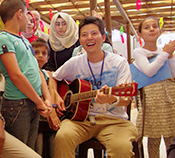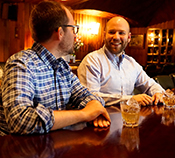Passing on folk instruments to the future.
(Part 2)
Ram Prasad Kadel / Founder of the Nepali Folk Musical Instrument Museum
A museum that reveres its collection of folk musical instruments.
The teachings of his Master inspired Ram Prasad Kadel to embark on a colossal project of collecting native folk musical instruments. His diligent and enduring efforts bore fruit in the form of a museum of musical instruments, opened to the public in 2002. Today, almost two decades later, the museum collection has grown to represent 655 varieties of musical instruments. He explains what it means to him to preserve the traditions of Nepal and pass them on to coming generations.
Taking responsibility as an archivist of narratives about musical instruments.
I set a few rules for myself regarding the collection of musical instruments. The first rule is to keep my hands off any instrument that is still being played. If an instrument is played, the community needs it. The second rule is to only accept an instrument if it can be restored to working condition or has been made from scratch for the museum. Most old instruments are passed down through generations. They represent the histories of their communities and deserve to be treated with respect. So do their owners. As a third rule, therefore, I make sure to thoroughly research the history and culture of a community before I contact them.
When a community donates an instrument, it’s my responsibility to keep tangible records on the instrument and its life story. The histories of these musical instruments are largely passed on orally, without written documentation of any form. Many of the owners are very old, with vast knowledge and authentic stories only they can tell. Yet it can be challenging to draw them out. Establishing a rapport with them is crucial, as face-to-face interviews are the only viable way of accessing the information they offer. I visit them as often as I can and focus all of my attention on their stories. It helps to be persistent. With enough encouragement, some owners come to play active parts in my project. Some contact me after my visits to offer more stories.

Aiming to preserve the national heritage of folk music.
The collection has enriched my knowledge and perspectives of folk musical instruments. I find it fascinating that most of the instruments are made from materials that can be easily found locally, such as timber, bark, and animal bones. I have also found an intriguing link between the various topographies of the Nepali landscape and the local traditional music different regions produce. Music in the plains, for example, tends to be higher pitched and faster in tempo, as flat grounds are suited for dancing freely in open space. In colder hillside and mountaintop villages, the music is slower and cozier, better for huddling together than for dancing.
I sometimes record the sounds of instruments that have never been recorded before. The audio records will help future generations know how the instruments should sound if they want to play them. Records like this are indispensable for keeping our music culture alive.
The Nepalese government introduced a new set of education policies in 1950. The policies were helpful for the country, but traditional music was left behind. My mission is to revive the music that Nepal has nurtured for centuries. My collection of musical instruments is part of a larger endeavor in my life: to archive all styles of Nepalese music and pass them on.

Wishing for a united world through music.
The museum opened in 2002 and moved to its current location in 2007. My collection is still far from complete. There are believed to be more than 1,300 kinds of musical instruments in Nepal. So far, 655 instruments are represented in the museum’s collection of 1,000 items. To offer quality information, I will be developing a typology for the instruments based on parameters such as the methods of playing. My first goal is to collect all of the instruments native to Nepal. From there I will branch out to the rest of South Asia. India, Sri Lanka, and other neighbors share so much in common in their cultures and religions, but their music has followed different paths through history. The variation of musical styles would make an interesting point of reference for the museum.
Music is life. It permeates the universe, even our bodies. We can clap our hands to make music. Even our hearts beat rhythms. Our singing voices make melodies. Our bodies are musical instruments; their sounds are intrinsic parts of music. A group of people communicating with one another is like a musical ensemble. The whole world is an epic symphony. Music is the uniting source of humanity.
In 2011, we began holding an annual International Folk Music Film Festival and Symposium, inviting musicians, filmmakers, researchers, ethnomusicologists, anthropologists and artists. Together we celebrate music by showcasing films and documentaries about the folk music and cultures of different countries and sharing our experiences and knowledge. The festival gives me the opportunity to further my initiatives to unite the people of Nepal, South Asia, and the rest of the world.

- Ram Prasad Kadel / Founder of the Nepali Folk Musical Instrument Museum
- Prasad Kadel, a Nepalese native, began a business of making and selling of Buddhist thangkas paintings in 1992. Three years later, he started collecting native musical instruments with a view to creating a museum showcasing the musical heritage of Nepal. The museum, opened in 2002, now houses more than 1,000 items representing 655 kinds of musical instruments. Kadel has also founded an annual folk music film festival to celebrate the musical cultures of Nepal and the rest of the world. Every day he plays the shankha, a horn fashioned from the shell of a large sea snail (Triton’s trumpet).
Interview Date:



